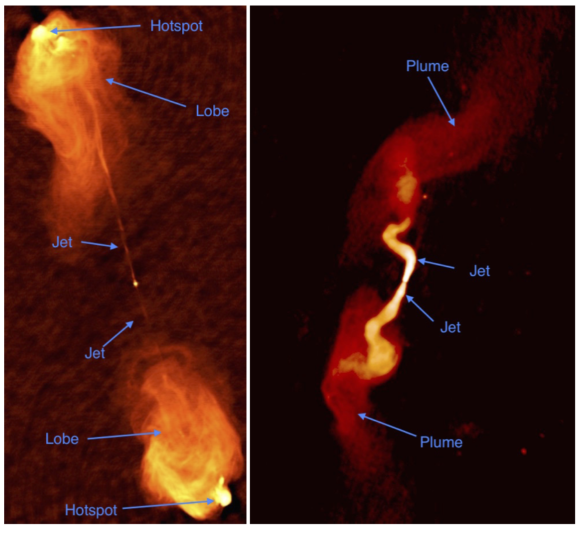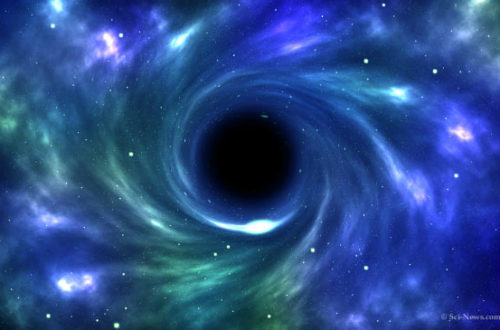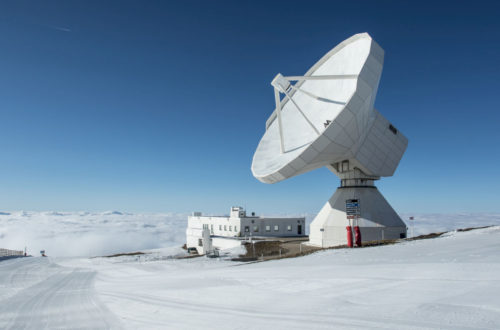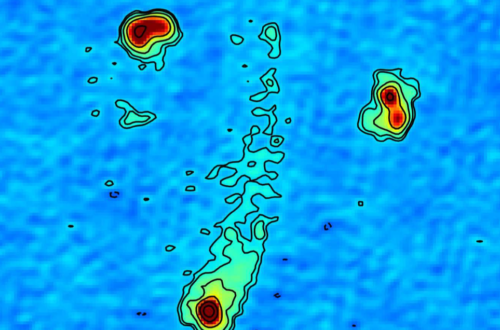Radio galaxies are powered by a central supermassive black hole feeding on surrounding matter. Some of this matter is ejected in opposing directions along the axis of rotation of the black hole in the form of powerful relativistic jets. These jets are launched with velocities close to the speed of light and travel vast distances away from their host galaxies. They emit radiation predominantly at radio frequencies, but also emit across the entire electromagnetic spectrum. Jets have a major impact on their surroundings. They can significantly heat their environments, reduce star formation and limit the growth of galaxies.
When observed at radio frequencies jets display a wide range of different appearances. Radio galaxies can be classified into one of two groups based on their large-scale appearance- Fanaroff and Riley Type I and Type II sources (Fanaroff & Riley 1974). These are referred to as FRI and FRII radio galaxies respectively.
FRII radio galaxies have powerful jets, which remain highly focused before terminating abruptly and inflating lobes of highly turbulent jet material (see left image of Figure 1). Hotspots- regions of intense radio emission, mark the location where the jets terminate. FRII jets are brightest at their leading edges.
FRI radio galaxies on the other hand have weak jets that are broader and display significant wiggles along their lengths. The jets smoothly transition into meandering plumes. FRI jets are brightest close to the host galaxy from which they are launched.

A small fraction of observed radio galaxies are classed as winged radio galaxies. Winged radio galaxies display peculiar and complex structures when observed at radio frequencies. Unlike the standard FRII radio galaxies which have one pair of radio lobes (see left image in Figure 1), winged radio galaxies have two pairs of radio lobes- the primary and secondary lobes (see Figure 2). The secondary radio lobes are termed ‘wings’ and are misaligned with the primary lobes, resulting in the unusual large-scale appearance.
X-shaped radio galaxies
If the wings are located symmetrically on either side of the host galaxy, and the primary lobes and wings are almost perpendicular to each other then this gives the radio galaxy a distinctive ‘X-shape’ (see Figures 2 and 3). These X-shaped radio galaxies are a subclass of winged radio galaxies and were discovered in the 1970s (Mackay 1969, Hogbom & Carlsson 1974).


The primary radio lobes in winged and X-shaped radio sources are associated with an ‘active’ jet, i.e. one that is still being launched by the black hole. The primary lobes often (but not always) display the hotspots that are characteristic of FRII sources- In fact winged/X-shaped radio galaxies are actually weak FRII sources, though something has clearly happened to them to give them wings. (And no, they have not been drinking Red Bull).
The secondary lobes, or wings, are fainter and do not appear to have an active jet or display hotspots. The wings can appear diffuse (smeared out) and more disturbed compared to the primary lobes. They may also be longer or shorter than the primary lobes.
How are the wings formed?
A number of different models have been proposed in order to explain how the wings in X-shaped (and winged) radio galaxies are formed. A few of these models are outlined below.
1. The spin-flip model:
The X-shape is produced when a jet suddenly changes its direction. In this model the axis of rotation of the black hole, or ‘spin axis’, changes orientation, which then causes the direction of the jet to change (e.g. Merritt & Ekers 2002, Dennett-Thorpe et al. 2002).
How does this happen? When two galaxies merge their central supermassive black holes spiral around each other, moving closer and closer until they eventually merge too. When the black holes merge together the axis of rotation of the resulting merged black hole will be different from that of the two black holes before the merger.
If one of the black holes is launching a jet along its spin axis before the merger and the resulting merged black hole also launches a jet, the jet will appear to change direction and the characteristic X-shape will be produced. The wings are therefore a relic of the old jet (launched before the black hole merger) and the primary lobes trace the path of the new jet following the merger event.
This model is particularly interesting since it would imply that X-shaped radio galaxies are associated with gravitational waves, a natural consequence of the merger between two black holes. Additionally X-shaped radio sources will then also be signposts of galaxy (and cluster) mergers.

(Faint Images of the Radio Sky at Twenty-centimeters) survey. The radio galaxies show a diverse range of shapes and were observed using the VLA (at 1.4 GHz). Image taken from Cheung 2008.
2. Interactions between the jets and their surroundings:
Steep density and pressure gradients in the surrounding environment (the intracluster and interstellar medium), alongside massive molecular clouds in the host galaxy may significantly deflect the primary lobes such that they form wings (e.g. Leahy & Williams 1984, Worrall et al. 1995, Kraft et al. 2005). X-shaped radio galaxies would therefore be very important sources for investigating how jets interact with their direct surroundings and how jets are deflected.
3. A galaxy with two central supermassive black holes:
In this model two supermassive black holes reside in close proximity to each other at the centre of a galaxy (e.g. Lal & Rao 2005). The supermassive black holes have different spin axes and so launch jets in different directions.
For this model to explain the X-shaped structure both black holes would have to be launching jets during the same period of time. It is unclear how likely this scenario is and it may in fact be very rare.
However, there is at least one example of two jetted supermassive black holes orbiting each other- the binary jet source 3C 75. The large scale appearance of 3C 75 however is not consistent with an X-shaped radio source as its host galaxy is zooming through the surrounding environment with a velocity of roughly 1200 kilometres per second.
It is important to note that none of the three models described above (or in fact any of the current models) is capable of successfully explaining the shape and properties of all the observed X-shaped/winged radio galaxies. How exactly the wings are formed remains unknown. A combination of new high resolution radio and X-ray observations alongside hydrodynamic/ magnetohydrodynamic simulations may be the key to unlocking this mystery.



